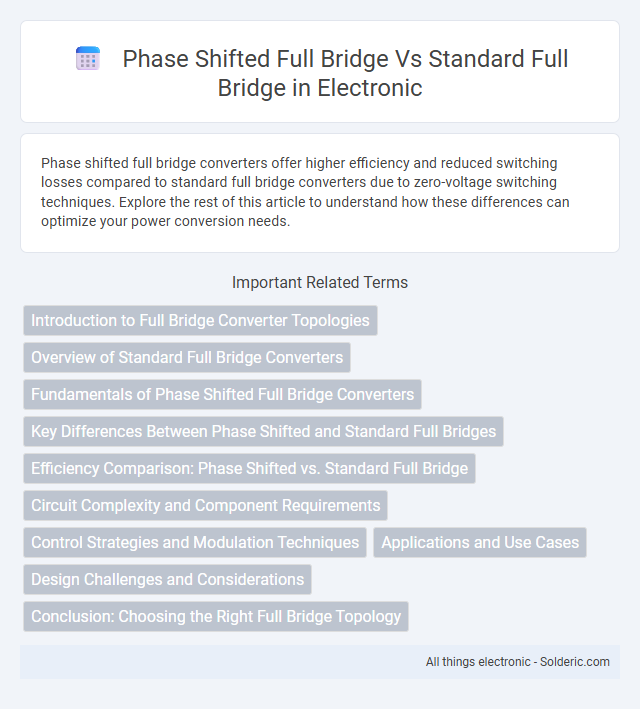Phase shifted full bridge converters offer higher efficiency and reduced switching losses compared to standard full bridge converters due to zero-voltage switching techniques. Explore the rest of this article to understand how these differences can optimize your power conversion needs.
Comparison Table
| Feature | Phase-Shifted Full Bridge (PSFB) | Standard Full Bridge (SFB) |
|---|---|---|
| Switching Method | Phase-shifted control with zero-voltage switching (ZVS) | Hard switching without zero-voltage switching |
| Efficiency | Higher efficiency due to reduced switching losses | Lower efficiency with higher switching losses |
| EMI | Reduced electromagnetic interference (EMI) | Higher EMI due to hard switching |
| Complexity | More complex control and timing requirements | Simple control and straightforward timing |
| Cost | Generally higher cost due to advanced control | Lower cost with simpler design |
| Applications | High-power, high-efficiency DC-DC converters | General-purpose power conversion |
| Thermal Management | Improved thermal performance due to less switching loss | Higher thermal stress on components |
Introduction to Full Bridge Converter Topologies
Full bridge converter topologies, including standard and phase-shifted variants, are widely used in power electronics for efficient DC-DC conversion. The standard full bridge employs four switches in a bridge configuration to drive the transformer, while the phase-shifted full bridge adds controlled switching timing to minimize voltage and current overlap, reducing switching losses. These differences impact efficiency, electromagnetic interference, and thermal performance in high-power applications.
Overview of Standard Full Bridge Converters
Standard full bridge converters utilize four switches arranged in an H-bridge configuration to efficiently convert DC voltage to AC, enabling precise control of power delivery in various applications. These converters offer robust performance, high efficiency, and are commonly used in medium to high power scenarios such as motor drives and power inverters. Your choice between phase shifted and standard full bridge topologies depends on factors like switching losses, voltage stress, and application-specific requirements.
Fundamentals of Phase Shifted Full Bridge Converters
Phase shifted full bridge converters utilize controlled phase shifting between bridge halves to achieve zero-voltage switching (ZVS), significantly reducing switching losses and electromagnetic interference compared to standard full bridge converters. This topology enables more efficient power conversion at high frequencies by precisely managing the overlap of voltage and current waveforms during the switching transitions. The resulting performance improvements make phase shifted full bridge converters ideal for high-power, high-efficiency applications such as electric vehicle chargers and server power supplies.
Key Differences Between Phase Shifted and Standard Full Bridges
Phase shifted full bridge converters utilize controlled phase shifts between switching legs to achieve zero-voltage switching (ZVS), significantly reducing switching losses and electromagnetic interference compared to standard full bridge converters. Standard full bridge topology operates with hard switching, causing higher switching losses and lower efficiency at high frequencies. Phase shifted designs enable improved thermal management and higher power density, making them ideal for high-efficiency power supply applications.
Efficiency Comparison: Phase Shifted vs. Standard Full Bridge
Phase shifted full bridge converters achieve higher efficiency than standard full bridge designs by significantly reducing switching losses through soft-switching techniques, such as zero-voltage switching (ZVS). This method minimizes electromagnetic interference and heat generation, resulting in improved thermal performance and longer component lifespan. Standard full bridge converters typically suffer from higher conduction and switching losses due to hard switching, leading to lower overall efficiency in high-frequency power conversion applications.
Circuit Complexity and Component Requirements
Phase shifted full bridge converters feature increased circuit complexity due to the need for additional control components like phase-shifting controllers and drivers, whereas standard full bridge converters maintain simpler designs with basic gating signals. Phase shifted topologies require fewer snubber circuits and offer reduced voltage stress on components, enabling the use of smaller, lower-cost switches compared to standard full bridge converters. Your choice depends on balancing the complexity and component count against efficiency and switching losses tailored to your specific application.
Control Strategies and Modulation Techniques
Phase shifted full bridge converters utilize phase shift modulation to achieve zero-voltage switching (ZVS), reducing switching losses and improving efficiency compared to standard full bridge converters. Standard full bridge converters commonly use pulse width modulation (PWM), which can lead to higher switching losses due to hard switching. Your choice of control strategy impacts converter efficiency, thermal performance, and electromagnetic interference (EMI) levels in power electronics applications.
Applications and Use Cases
Phase shifted full bridge converters excel in high-efficiency power supplies for servers, telecom equipment, and battery chargers, where soft switching reduces switching losses and electromagnetic interference. Standard full bridge converters find widespread use in industrial motor drives, welding machines, and uninterruptible power supplies due to their simpler design and capability to handle higher power levels without complex control schemes. Both topologies serve critical roles in renewable energy inverters and DC-DC converters, with the phase shifted design preferred for applications demanding higher efficiency and reduced thermal stress.
Design Challenges and Considerations
Phase shifted full bridge converters require precise timing control to achieve zero-voltage switching (ZVS), reducing switching losses compared to standard full bridge designs. The complexity of controlling the phase shift demands advanced gate driver circuits and careful synchronization, increasing design difficulty and component cost. Thermal management also becomes critical due to higher switching frequencies and the need to balance switching transitions with conduction losses in both topologies.
Conclusion: Choosing the Right Full Bridge Topology
Phase shifted full bridge converters offer higher efficiency and reduced switching losses through zero-voltage switching (ZVS) compared to standard full bridge converters, which typically experience higher switching losses due to hard switching. When prioritizing thermal management and energy efficiency in high-power applications, the phase shifted full bridge topology is preferable for its improved performance and reliability. For simpler designs with lower complexity or cost constraints, a standard full bridge converter remains a viable choice, especially in lower power scenarios.
Phase shifted full bridge vs Standard full bridge Infographic

 solderic.com
solderic.com